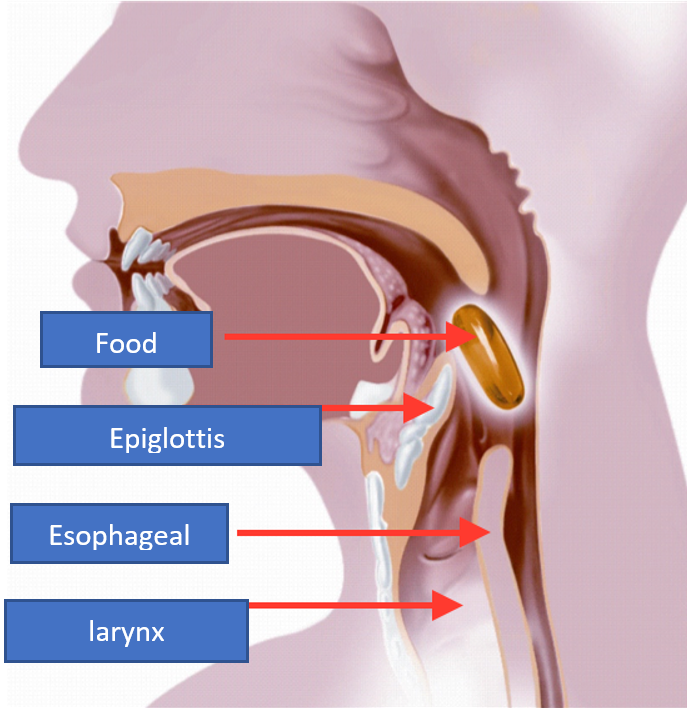Swallowing disorders, especially aspiration, can lead to many serious, even fatal, consequences. Therefore, we need to know the manifestations of swallowing disorders so that we can take preventive measures and treat them.
Doctor. Nguyen Duc Thanh, Head of Rehabilitation Department - University of Medicine and Pharmacy Hospital, Ho Chi Minh City said: "Swallowing disorders in patients after stroke or some other diseases are very common, and if not treated properly, it can lead to many serious consequences, even fatal ending”.
What is a swallowing disorder?
Normally, the process of swallowing food takes place in three stages: the oral phase, the pharyngeal phase, and the esophageal phase. During the oral phase, the food in the oral cavity is softened by saliva, then crushed and transported down the pharynx. The pharynx is the intermediate area between the mouth and the esophagus and is where the actual swallowing process begins, which is when food moves slowly from the mouth down the esophagus. In the pharynx there is a "junction" where the airways (larynx) meet in front and the food passages (esophagus) are just behind. At the top of the airways is a structure called the "glottis", which is responsible for closing the larynx (so that food does not fall in) while food passes through this junction to the esophagus. When for some reason food or drink does not pass through the esophagus to the stomach as usual, but "wrongly" enters the larynx and falls into the airway, this condition is called "aspiration". And this is the most typical and common manifestation of swallowing disorder. In addition, swallowing disorder is also caused by the weakness of the swallowing muscles, which is the result of many different diseases, most often caused by stroke, which interferes with the process of transporting food and water from the mouth to esophagus.

Swallowing process (photo source: Internet)
Causes of swallowing disorders
There are many medical conditions that can cause swallowing disorders. Most often due to the following diseases:
- Stroke.
- Traumatic brain injury.
- Spinal cord injury.
- Parkinson's.
- Cerebral palsy.
- Dementia.
- Tumors or surgical scars in the mouth, throat, esophagus.
Manifestations of swallowing disorder
Swallowing disorders, especially aspiration, can lead to many serious, even fatal, consequences. Therefore, we need to know the manifestations of swallowing disorders so that we can take preventive measures and treat them. The most common and typical manifestations of swallowing disorders include:
Cough while or immediately after eating or drinking.
Clearing throat repeatedly after eating or drinking.
- Voice changes after eating or drinking (voice becomes "wet").
A feeling of tightness in the throat or behind the breastbone after eating or drinking.
- The time to chew and swallow food is significantly longer than usual.
- Food and drink spill out of the mouth while eating.
- Food remains in the oral cavity after eating.
Shortness of breath after eating or drinking.
Consequences of swallowing disorders
Swallowing disorders can lead to serious consequences such as:
Fear of eating, especially when eating with other people.
- Malnutrition.
- Depression, self-isolation, social alienation.
- Aspiration, leading to pneumonia, respiratory failure, can cause death. Especially in elderly patients, due to poor cough reflex, there may be "silent aspiration", that is, there are no obvious symptoms and it is difficult to detect until there are complications.
Swallowing disorders treatment
There are many treatments for swallowing disorders. Which method to choose depends on the cause of the swallowing disorder. Common methods include:
- Change the type of food and drink accordingly.
- Change position when eating to be safer.
- Strong exercise of swallowing muscles, electrical stimulation of swallowing muscles.
- Insert a nasogastric tube or do gastric bypass surgery to feed (applicable to cases where the disease is too severe, unable to do anything else).
- Use of "thickeners".
Role of "thickeners" in the treatment of swallowing disorders
For the average person, while eating or talking, if you are not careful, you can sometimes choke. The simplest is choking on saliva. It is more common to choke when drinking water, especially in the elderly, when the swallowing muscles are weakened and the swallowing reflex is also worse than in young people. The possibility of choking also depends on how thick or liquid the food is. In general, the more liquid the food, the more likely it is to cause choking, which means it is easier to get into the airways instead of the esophagus.
Conversely, foods that are too solid, too dry, can cause choking, which means getting stuck on the way down the esophagus. Ideal for both ease of descent and long enough circulation time to avoid getting lost in the airways are foods of moderate consistency such as yogurt, ice cream, and pudding. etc…However, in reality no one eats only a few kinds of such foods. Therefore, the question is how can patients with swallowing disorder eat and drink any food according to their wishes without fear of choking? That is also the reason why "thickeners" are used in clinical treatment.

Powder thickener (photo source: Internet)
"Thickeners" (English: thickeners) are special substances, in powder or gel form, that are used to mix food and drink, to help increase the density or viscosity of food, thereby help food easily move right into the food line and not into the wrong airway, avoiding aspiration for the patient. Thickeners generally have no taste or color and therefore do not change the properties of the food, except to increase the consistency of the food. In developed countries, thickeners have been used in clinical treatment for a long time. There are many studies in the world that show that the use of "thickeners" is a simple but effective and safe solution in the treatment of swallowing disorders in general and aspiration in particular.

Thickeners help patients with swallowing disorders can eat almost all foods according to their wishes without fear of choking (photo source: Internet)
Currently, in our country, it is very common for patients to have swallowing disorders due to various diseases, especially stroke. However, it is a pity that the majority of patients have not been paid enough attention to the treatment of swallowing disorders, but the treatment process mainly focuses on strengthening the paralyzed limb muscles, learning to move, walking, living, etc... Therefore, in clinical practice, there are many cases of swallowing disorders that are only detected when the patient has complications such as pneumonia, respiratory failure, malnutrition; and when the process of dealing with these consequences was not timely and ineffective, it eventually led to the very unfortunate death of the patient.
There are many reasons to explain this situation. The first is because the community's understanding of swallowing disorders is still limited. Second, more importantly, there are not many medical staff with extensive training in the management of swallowing disorders (speech therapists). The third is because the patients live in remote areas and do not have access to medical facilities capable of treating swallowing disorders. Another reason is that aids in the treatment of swallowing disorders such as "thickeners" are not yet in the same official supply as pharmaceuticals, and are therefore not widely available and not readily available.
Eating right is not only one of the basic functions that keep our bodies healthy, it also carries emotional, social and cultural meanings and values. Hopefully in the not too distant future the above-mentioned difficulties will be solved, and we will have more effective "weapons" to use in the fight against disease, thereby bringing quality treatment. and better quality of life for patients with swallowing disorders.

Source: https://suckhoedoisong.vn/
By Mr.Tien Phap


 Vietnamese
Vietnamese  日本語
日本語  English
English 



